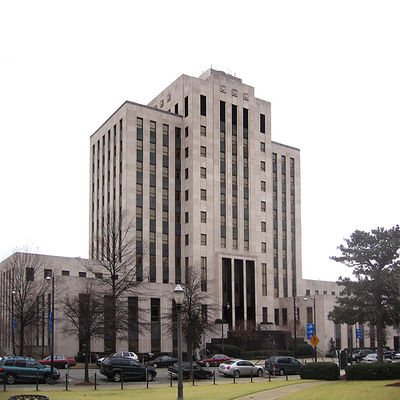Birmingham City Hall
- For earlier city halls, see Birmingham City Hall (disambiguation)
The Birmingham City Hall is the primary governmental office building for the city of Birmingham. The 12-story modern-style building faces Linn Park from across 20th Street North, on Block 20 between Park Place and 8th Avenue North.
The project for a new City Hall was led by then-Birmingham City Commission president Cooper Green. The choice of whether to rebuild on the same 4th Avenue North site as the 1901 Birmingham City Hall or to move city government to the "Municipal Plaza" was made the subject of a November 7, 1944 referendum.
The building was constructed in 1950 for $3,850,000, which was paid for before the building opened without a bond issue or raising new taxes. The building, which complements the 1932 Jefferson County Courthouse opposite the park, is accented by contrasting vertical bands of limestone and granite. The architect was Charles McCauley and the builder was J. A. Jones Construction Co..
The cornerstone was laid at an August 3, 1950 dedication ceremony, shortly before the project was completed. Governor Jim Folsom, Sr attended and statements were given by Francis McCormack of St Anthony's Catholic Church, Abraham Mesch of Temple Beth-El, and John Googame, Jr of 6th Avenue Baptist Church. David A. Lawrence, the Mayor of Pittsburgh and President of the U. S. Conference of Mayors, gave the dedication address. Hill Ferguson of the Birmingham Historical Society placed the cornerstone time capsule, to be opened in 2050. The cornerstones of the previous City Halls were incorporated into a sculpture for the south entrance.
The "Design for Progress" model of Birmingham was converted into an interactive exhibit for City Hall's lobby in the 1970s, with push-buttons around the perimeter activating small indicator lights at the locations of various landmarks and attractions.
The City Council chambers were refitted in November 2005 in order to accommodate the needs of then-newly-elected Councilor Miriam Witherspoon, who used a wheelchair. Between 2009 and early 2011 work was completed to remove the entrance steps on the West 20th Street side of the building and replace them with new street level handicap accessible entrances. Previously handicapped persons had to use the annex entrance, which was usually locked.
A cafeteria in the basement of City Hall, formerly called a "Snack Bar", has been operated since 2022 by Tremayne and Karen Thompson as the "Perfect Note Express". In April 2023 the Council approved another renovation of the finishes, seating, sound and lighting in its chambers. The project, was awarded to Sherrod Construction with a $296,000 bid. The work took longer than expected and the cost increased to around $500,000 before the council resumed use of the space in January 2024.
Rooms
In the 1964 city directory, City Hall offices were distributed as follows:
- Basement
- B103: City Hall Snack Bar
- B104: Building Superintendent
- B106: Radio Stations KIB 664 and KIB 63
- Crisis Center (1970–1973)
- 1st floor
- 101: Recorder's Court, Court Room
- 102: Recorder's Court
- 103-113: Recorder's Court Reporters
- 104: Records Court Clerk
- 106-107: Radio Stations KIA 580, KIB 664 and KIB 63
- 110: Birmingham Department of Public Safety Parole and Probation Division
- 114-115: Birmingham Traffic Court
- 116-127: Birmingham Department of Public Safety
- 2nd floor
- 201-205: Birmingham Department of Finance and General Administration, Birmingham Department of Public Improvements
- 207: Birmingham Department of Public Improvements, Birmingham Department of Inspection Services
- 220: Birmingham Department of Finance and General Administration, Birmingham Planning and Zoning Board
- 3rd floor
- 300: Birmingham City Council chambers
- 303-306: Mayor of Birmingham
- 305-307: vacant
- 310: vacant
- 312-318: Birmingham City Clerk office, Birmingham City Council
- 4th floor
- 401-404: City Press Room
- 405: Birmingham Industrial Water Board
- 406: Birmingham Department of Finance and General Administration Bureau of Weights and Measures, Birmingham Department of Public Improvements Street Lighting Division
- 5th floor
- Birmingham Department of Public Improvements, Engineering Division
- 6th floor
- 600-613: Birmingham Department of Finance and General Administration, Legal Division
- 7th floor
- 8th floor
- 800: Jefferson County Civil Defense/Birmingham Police Department Auxiliary Police
- 803: Birmingham Symphony Association
- 807: Birmingham Department of Public Safety
- 808-810: vacant
- 811: Birmingham City Employees Credit Union
- 9th floor
- 900: Birmingham Department of Public Safety, Traffic Engineering Division
- 911: Birmingham Department of Public Improvements, Streets and Sanitation Division
- 10th floor
Gallery
References
- "Birmingham Citizens To Vote On Where To Build City Hall" (October 1944) The Birmingham News - via Birmingham Rewound
- Polk's Birmingham (Jefferson County, Ala.) City Directory (1964) Richmond, Virginia: R. L. Polk & Co.
- White, Marjorie Longenecker (1977) Downtown Birmingham: Architectural and Historical Walking Tour Guide. Birmingham: Birmingham Historical Society.
- O'Leary, A. J. (March 10, 2022) "Hoover restaurateurs open cafe in Birmingham City Hall." Birmingham Business Journal
- Garrison, Greg (April 5, 2023) "Birmingham City Council chambers will get $296,000 face-lift." AL.com
External links
- City of Birmingham official website
- Official Program: Dedication and Centerstone Laying Of The New City Hall" (August 3, 1950) from the Frank W. Boykin papers at the Alabama Department of Archives and History


